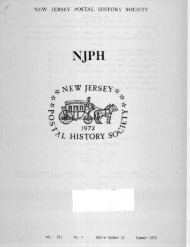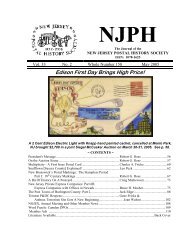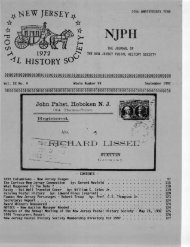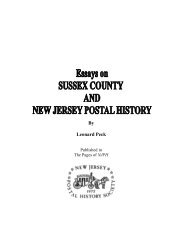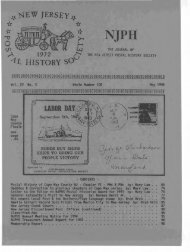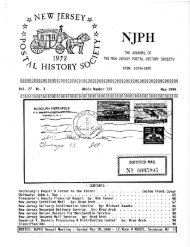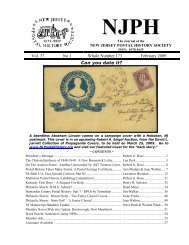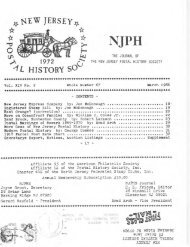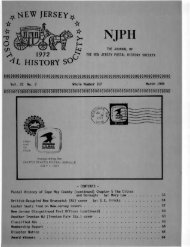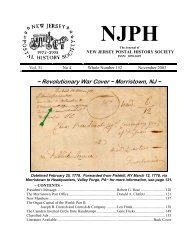185 - New Jersey Postal History Society
185 - New Jersey Postal History Society
185 - New Jersey Postal History Society
You also want an ePaper? Increase the reach of your titles
YUMPU automatically turns print PDFs into web optimized ePapers that Google loves.
FROM GUADALCANAL TO THE GARDEN STATE, Part I ~ Lawrence Brennan<br />
THE LANDINGS<br />
Fig. 8: Guadalcanal landing map from Shaw’s article. 14<br />
Once landed, the primary objective was the air strip.<br />
The U.S. planning for the invasion and capture of Guadalcanal and its dependent islands<br />
was abbreviated. Within seven months of the opening of hostilities and soon after the agreement<br />
between the Combined Chiefs of Staff of the US and UK to give priority to the war against<br />
Germany, after the successes at Coral Sea and Midway, the holding action in the Pacific was<br />
expanded to preventing the Japanese from interrupting the sea lanes between the United States<br />
and Australia and <strong>New</strong> Zealand. As explained in Morison, U.S. Naval Operations Vol. V:<br />
This first offensive, Operation "Watchtower," was ordered by the Joint<br />
Chiefs of Staff at Washington on 2 July 1942. The ultimate objective was defined as<br />
“seizure and occupation of the <strong>New</strong> Britain-<strong>New</strong> Ireland-<strong>New</strong> Guinea area,”<br />
including the principal enemy base at Rabaul. Task No. 1, with target date 1 August,<br />
was to be seizure of the Santa Cruz Islands, Tulagi and adjacent positions. But on 4<br />
July an Allied reconnaissance plane reported that the Japanese were starting work<br />
on an airfield - the future Henderson Field - near Lunga Point, Guadalcanal.<br />
That is why this large and fecaloid island became the immediate and urgent<br />
Allied objective. For, if the enemy were allowed to complete the Lunga field and to<br />
base planes there, he might be able to knock out Espiritu Santo, Efate or even<br />
Kumac, the northern airfield on <strong>New</strong> Caledonia.<br />
The planning for the invasion of Guadalcanal benefited greatly from photoreconnaissance,<br />
an art which had been learned by U.S. Naval observers in Great Britain in 1941.<br />
The flag officer in overall command of the invasion force was Commander South Pacific, Vice<br />
NJPH 14<br />
Vol. 40/No. 1<br />
Feb 2012 Whole No. <strong>185</strong>



